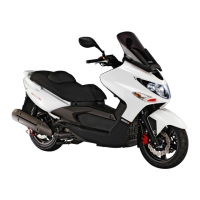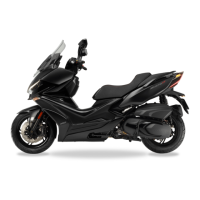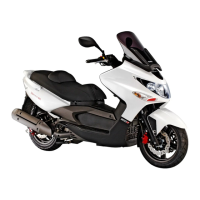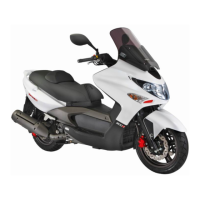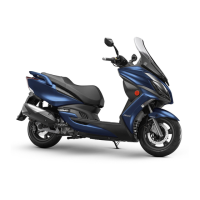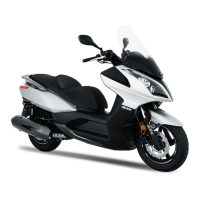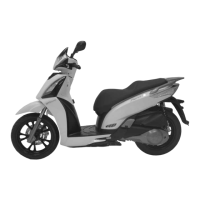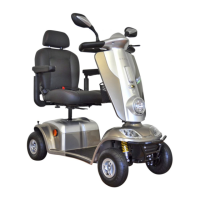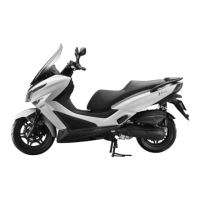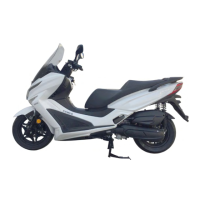Do you have a question about the KYMCO Xciting 300i and is the answer not in the manual?
Emphasizes the importance of understanding the manual before operation.
Explains the meaning of WARNING, CAUTION, and NOTE symbols for safety.
General guidelines for safe scooter operation and rider responsibility.
Recommends wearing approved helmets and eye protection for safety.
Tips for increasing rider visibility and using signals effectively.
Advises riding within personal skill boundaries to avoid accidents.
Emphasizes regular maintenance and avoiding overloading for safe riding.
Highlights the importance of performing a safety inspection before each ride.
Provides precautions for riding in wet or slippery conditions.
Warns against modifying the scooter, as it may render it unsafe or illegal.
Details on helmet fit and importance of eye protection.
Suggests sturdy boots, gloves, and bright clothing for safety.
Visual guide to recommended protective gear for riding.
Details maximum weight capacities for the scooter and its compartments.
Specifies the maximum total weight the scooter can carry.
Defines the maximum weight allowed for cargo.
Lists weight limits for individual storage compartments.
Provides instructions for properly loading cargo and passengers to ensure stability.
Warns against modifying the scooter, as it may render it unsafe or illegal.
Provides critical safety advice before starting the engine.
Offers safety advice regarding filter replacement and component placement.
Covers safety, maintenance, and technical specifications like tire size and load.
Warns about mobile phone charging and using organic solvents for cleaning.
Identifies external parts like mirrors, switches, and suspension adjusters.
Locates components like throttle grip, brake levers, and fluid reservoirs.
Locates tool kit, compartments, stands, and air cleaner.
Identifies seat, backrest, battery, and phone socket locations.
Describes how to use the ignition and shutter keys.
Details the functions of the ignition switch positions.
Explains the meaning of different ignition switch positions (OFF, ON, LOCK, etc.).
Illustrates the layout of the scooter's instrument panel with numbered components.
Describes the meaning of various indicator lights like oil pressure and battery charge.
Explains fuel refill, seat unlock, side stand, high beam, and trip meter indicators.
Details clock, hour adjust, oil service, check engine, and parking brake indicators.
Explains the operation of the headlight switch for different light settings.
Describes how to use the electric starter button.
Details the functions of the engine stop and hazard warning switches.
Explains how to use the turn signal switch for changing lanes or turning.
Describes how to operate the horn.
Explains how to switch between high and low beam headlights.
Describes the function of the passing light switch.
Explains the operation of the left handlebar combination brake lever.
Describes the operation of the right handlebar front brake lever.
Details how to apply and release the parking brake.
Explains how to open and close the fuel fill cap.
Instructions on how to securely lock the fuel fill cap after refueling.
Recommends unleaded petrol with a specific octane number for optimal performance.
Explains the automatic operation of the compartment light.
Details the cell phone socket and mounting seat, including capacity.
Provides instructions for securing a cell phone in the fixed seat.
Instructions for placing the scooter on the center stand.
Explains the side stand function and its ignition cut-off system.
Warns about incompletely retracted side stands and proper parking procedures.
Step-by-step guide for starting the engine, including safety and system checks.
Details the sequence for placing on center stand, engaging parking brake, and ignition.
Covers turning ignition ON, checking oil light, and engaging the starter.
Instructs on warming up the engine, throttle control, and not leaving unattended.
Explains the automatic engine stop feature for overturned scooters.
Advises allowing engine oil to circulate before applying load or revving.
Reminds about reviewing safety and avoiding flammable materials near exhaust.
Instructions on safely moving the scooter off the center stand.
Details pushing the scooter off the stand and mounting it safely.
Covers unlocking the brake, signaling, and grasping handlebars for safe departure.
Explains gradual throttle use for acceleration and closing for deceleration.
Emphasizes coordinated use of front and rear brakes for effective stopping.
Guides on braking for corners and descending steep grades.
Steps for stopping the engine, removing the key, and using the center stand.
Advice on parking on slopes to prevent rolling or overturning.
Precautions for riding in adverse conditions like rain or slippery surfaces.
Instructions for locking the steering and warnings about the hot muffler.
Recommends throttle limits for the initial 800 km and up to 1600 km.
Explains the importance of varying engine speed for proper part mating.
Warns against sustained low-speed operation during break-in.
Guides on breaking in new tires for maximum performance and safety.
Highlights the importance of the 1000 km service for scooter longevity.
Stresses the role of maintenance in ensuring safety, economy, and performance.
Introduces the maintenance schedule for regularly scheduled upkeep.
Details the maintenance tasks and intervals for the XCITING 500 i/Ri model.
Lists maintenance items like air cleaner, engine oil, and fuel line with intervals.
Covers brake system, side stand, suspension, and tire maintenance intervals.
Details the maintenance tasks and intervals for the XCITING 300i/Ri model.
Lists maintenance for air cleaner, engine oil, and fuel line for 300i/Ri.
Covers brake system, side stand, suspension, and tire maintenance for 300i/Ri.
Identifies the location and purpose of the supplied tool kit.
Instructions for servicing the crankcase breather tube and its deposits.
Recommends premium 4-stroke motor oil and viscosity for engine longevity.
Provides a chart for selecting engine oil viscosity based on temperature.
Details the procedure for checking the engine oil level using the dipstick.
Step-by-step guide for changing the engine oil, including disposal advice.
Covers removing the drain plug, filling with new oil, and checking the level.
Details replacing the oil filter cartridge, recommending dealer service if needed.
Instructions for removing, cleaning, and inspecting the oil strainer screen.
Specific steps for removing and installing the oil filter cartridge for XCITING 500 i/Ri.
Covers applying oil to the seal and tightening the new oil filter cartridge.
Details installing the oil strainer cap, filling with oil, and final checks.
Instructions for draining the transmission oil.
Details filling the transmission case with recommended oil and tightening the fill bolt.
Instructions for removing and replacing the air cleaner element for the 500 i/Ri.
Guides on installing a new air cleaner element and its importance.
Details replacing the air cleaner element for the 300 i/Ri model.
Checks for smooth rotation and measures throttle grip free play.
Instructions for adjusting the throttle cable adjuster and tightening the lock nut.
Details cleaning carbon deposits and readjusting the spark plug gap.
Recommends periodic replacement and explains signs of improper heat range.
Explains how to check the coolant level in the reserve tank and add coolant.
Details coolant replacement, recommending dealer service and caution with hot radiator caps.
Recommends high-quality antifreeze and distilled water for the cooling system.
Checks spring tension, assembly freedom, and ignition cut-off system function.
Explains how to adjust the brake lever position for operator comfort.
Details checking front and rear brake fluid levels and inspecting pads.
Guides on checking brake pad wear and when to replace them.
Details how to inspect the parking brake lever stroke and adjustment.
Step-by-step instructions for removing and installing the scooter battery.
Explains how to replace fuses, lists fuse ratings, and their functions.
Details the fuse box location and how to replace fuses.
Details the charge fuse location and how to replace it.
Warns about the consequences of not following tire maintenance instructions.
General instructions for tire care, including condition, pressure, and replacement.
Explains the importance of correct tire pressure and provides cold inflation values.
Details how to check tire tread condition and identifies wear limits.
Lists recommended tire sizes and warns about improper repair or balancing.
Provides instructions and warnings for repairing and replacing tubeless tires.
Recommends regular cleaning and avoiding harsh detergents or high-pressure sprays.
Step-by-step instructions for washing the scooter with cool water.
Details cleaning plastic parts and warns about chemical damage.
Instructions for rinsing, drying, and running the engine after washing.
Suggests using spray cleaner/polish or wax for a finished look after washing.
Instructions for cleaning salt residue to prevent rust.
Advice on cleaning aluminum wheels to prevent corrosion from road salt.
Tips for cleaning the stainless steel exhaust pipe and removing heat stains.
Instructions for cleaning the windshield with water or mild detergent, avoiding chemicals.
Steps for preparing the scooter for extended storage, including oil and fuel.
Instructions for preventing cylinder rust during storage using engine oil.
Advice on storing the battery and inflating tires for extended periods.
Steps for preparing the scooter after storage, including checks and test rides.
Lists the overall dimensions and dry weight of the XCITING 500 i/Ri.
Details engine oil, transmission oil, and fuel tank capacities for the 500 i/Ri.
Provides technical specifications for engine, chassis, and electrical systems.
Lists the overall dimensions and dry weight of the XCITING 300 i/R.
Details engine oil, transmission oil, and fuel tank capacities for the 300 i/R.
Provides technical specifications for engine, chassis, and electrical systems.
Introduces the ABS system, its function, and characteristics.
Discusses ABS operation with tires, speed, and battery conditions.
Emphasizes the importance of understanding the manual before operation.
Explains the meaning of WARNING, CAUTION, and NOTE symbols for safety.
General guidelines for safe scooter operation and rider responsibility.
Recommends wearing approved helmets and eye protection for safety.
Tips for increasing rider visibility and using signals effectively.
Advises riding within personal skill boundaries to avoid accidents.
Emphasizes regular maintenance and avoiding overloading for safe riding.
Highlights the importance of performing a safety inspection before each ride.
Provides precautions for riding in wet or slippery conditions.
Warns against modifying the scooter, as it may render it unsafe or illegal.
Details on helmet fit and importance of eye protection.
Suggests sturdy boots, gloves, and bright clothing for safety.
Visual guide to recommended protective gear for riding.
Details maximum weight capacities for the scooter and its compartments.
Specifies the maximum total weight the scooter can carry.
Defines the maximum weight allowed for cargo.
Lists weight limits for individual storage compartments.
Provides instructions for properly loading cargo and passengers to ensure stability.
Warns against modifying the scooter, as it may render it unsafe or illegal.
Provides critical safety advice before starting the engine.
Offers safety advice regarding filter replacement and component placement.
Covers safety, maintenance, and technical specifications like tire size and load.
Warns about mobile phone charging and using organic solvents for cleaning.
Identifies external parts like mirrors, switches, and suspension adjusters.
Locates components like throttle grip, brake levers, and fluid reservoirs.
Locates tool kit, compartments, stands, and air cleaner.
Identifies seat, backrest, battery, and phone socket locations.
Describes how to use the ignition and shutter keys.
Details the functions of the ignition switch positions.
Explains the meaning of different ignition switch positions (OFF, ON, LOCK, etc.).
Illustrates the layout of the scooter's instrument panel with numbered components.
Describes the meaning of various indicator lights like oil pressure and battery charge.
Explains fuel refill, seat unlock, side stand, high beam, and trip meter indicators.
Details clock, hour adjust, oil service, check engine, and parking brake indicators.
Explains the operation of the headlight switch for different light settings.
Describes how to use the electric starter button.
Details the functions of the engine stop and hazard warning switches.
Explains how to use the turn signal switch for changing lanes or turning.
Describes how to operate the horn.
Explains how to switch between high and low beam headlights.
Describes the function of the passing light switch.
Explains the operation of the left handlebar combination brake lever.
Describes the operation of the right handlebar front brake lever.
Details how to apply and release the parking brake.
Explains how to open and close the fuel fill cap.
Instructions on how to securely lock the fuel fill cap after refueling.
Recommends unleaded petrol with a specific octane number for optimal performance.
Explains the automatic operation of the compartment light.
Details the cell phone socket and mounting seat, including capacity.
Provides instructions for securing a cell phone in the fixed seat.
Instructions for placing the scooter on the center stand.
Explains the side stand function and its ignition cut-off system.
Warns about incompletely retracted side stands and proper parking procedures.
Step-by-step guide for starting the engine, including safety and system checks.
Details the sequence for placing on center stand, engaging parking brake, and ignition.
Covers turning ignition ON, checking oil light, and engaging the starter.
Instructs on warming up the engine, throttle control, and not leaving unattended.
Explains the automatic engine stop feature for overturned scooters.
Advises allowing engine oil to circulate before applying load or revving.
Reminds about reviewing safety and avoiding flammable materials near exhaust.
Instructions on safely moving the scooter off the center stand.
Details pushing the scooter off the stand and mounting it safely.
Covers unlocking the brake, signaling, and grasping handlebars for safe departure.
Explains gradual throttle use for acceleration and closing for deceleration.
Emphasizes coordinated use of front and rear brakes for effective stopping.
Guides on braking for corners and descending steep grades.
Steps for stopping the engine, removing the key, and using the center stand.
Advice on parking on slopes to prevent rolling or overturning.
Precautions for riding in adverse conditions like rain or slippery surfaces.
Instructions for locking the steering and warnings about the hot muffler.
Recommends throttle limits for the initial 800 km and up to 1600 km.
Explains the importance of varying engine speed for proper part mating.
Warns against sustained low-speed operation during break-in.
Guides on breaking in new tires for maximum performance and safety.
Highlights the importance of the 1000 km service for scooter longevity.
Stresses the role of maintenance in ensuring safety, economy, and performance.
Introduces the maintenance schedule for regularly scheduled upkeep.
Details the maintenance tasks and intervals for the XCITING 500 i/Ri model.
Lists maintenance items like air cleaner, engine oil, and fuel line with intervals.
Covers brake system, side stand, suspension, and tire maintenance intervals.
Details the maintenance tasks and intervals for the XCITING 300i/Ri model.
Lists maintenance for air cleaner, engine oil, and fuel line for 300i/Ri.
Covers brake system, side stand, suspension, and tire maintenance for 300i/Ri.
Identifies the location and purpose of the supplied tool kit.
Instructions for servicing the crankcase breather tube and its deposits.
Recommends premium 4-stroke motor oil and viscosity for engine longevity.
Provides a chart for selecting engine oil viscosity based on temperature.
Details the procedure for checking the engine oil level using the dipstick.
Step-by-step guide for changing the engine oil, including disposal advice.
Covers removing the drain plug, filling with new oil, and checking the level.
Details replacing the oil filter cartridge, recommending dealer service if needed.
Instructions for removing, cleaning, and inspecting the oil strainer screen.
Specific steps for removing and installing the oil filter cartridge for XCITING 500 i/Ri.
Covers applying oil to the seal and tightening the new oil filter cartridge.
Details installing the oil strainer cap, filling with oil, and final checks.
Instructions for draining the transmission oil.
Details filling the transmission case with recommended oil and tightening the fill bolt.
Instructions for removing and replacing the air cleaner element for the 500 i/Ri.
Guides on installing a new air cleaner element and its importance.
Details replacing the air cleaner element for the 300 i/Ri model.
Checks for smooth rotation and measures throttle grip free play.
Instructions for adjusting the throttle cable adjuster and tightening the lock nut.
Details cleaning carbon deposits and readjusting the spark plug gap.
Recommends periodic replacement and explains signs of improper heat range.
Explains how to check the coolant level in the reserve tank and add coolant.
Details coolant replacement, recommending dealer service and caution with hot radiator caps.
Recommends high-quality antifreeze and distilled water for the cooling system.
Checks spring tension, assembly freedom, and ignition cut-off system function.
Explains how to adjust the brake lever position for operator comfort.
Details checking front and rear brake fluid levels and inspecting pads.
Guides on checking brake pad wear and when to replace them.
Details how to inspect the parking brake lever stroke and adjustment.
Step-by-step instructions for removing and installing the scooter battery.
Explains how to replace fuses, lists fuse ratings, and their functions.
Details the fuse box location and how to replace fuses.
Details the charge fuse location and how to replace it.
Warns about the consequences of not following tire maintenance instructions.
General instructions for tire care, including condition, pressure, and replacement.
Explains the importance of correct tire pressure and provides cold inflation values.
Details how to check tire tread condition and identifies wear limits.
Lists recommended tire sizes and warns about improper repair or balancing.
Provides instructions and warnings for repairing and replacing tubeless tires.
Recommends regular cleaning and avoiding harsh detergents or high-pressure sprays.
Step-by-step instructions for washing the scooter with cool water.
Details cleaning plastic parts and warns about chemical damage.
Instructions for rinsing, drying, and running the engine after washing.
Suggests using spray cleaner/polish or wax for a finished look after washing.
Instructions for cleaning salt residue to prevent rust.
Advice on cleaning aluminum wheels to prevent corrosion from road salt.
Tips for cleaning the stainless steel exhaust pipe and removing heat stains.
Instructions for cleaning the windshield with water or mild detergent, avoiding chemicals.
Steps for preparing the scooter for extended storage, including oil and fuel.
Instructions for preventing cylinder rust during storage using engine oil.
Advice on storing the battery and inflating tires for extended periods.
Steps for preparing the scooter after storage, including checks and test rides.
Lists the overall dimensions and dry weight of the XCITING 500 i/Ri.
Details engine oil, transmission oil, and fuel tank capacities for the 500 i/Ri.
Provides technical specifications for engine, chassis, and electrical systems.
Lists the overall dimensions and dry weight of the XCITING 300 i/R.
Details engine oil, transmission oil, and fuel tank capacities for the 300 i/R.
Provides technical specifications for engine, chassis, and electrical systems.
Introduces the ABS system, its function, and characteristics.
Discusses ABS operation with tires, speed, and battery conditions.
| Cooling System | Liquid-cooled |
|---|---|
| Fuel System | Electronic Fuel Injection |
| Transmission | CVT |
| Front Suspension | Telescopic fork |
| Front Brake | Disc |
| Rear Brake | Disc |
| Seat Height | 800 mm |
| Compression Ratio | 10.5:1 |
| Max Torque | 23.5 Nm @ 6500 rpm |
| Starting System | Electric |
| Front Tire | 120/70-15 |
| Rear Tire | 150/70-14 |
| Wheelbase | 1565 mm |
| Engine Type | Liquid-cooled, 4-stroke, SOHC |
| Rear Suspension | Dual shock |
| Bore x Stroke | 72.7 x 72 mm |
| Ignition | Electric |

